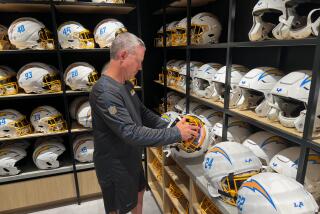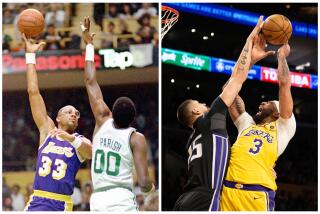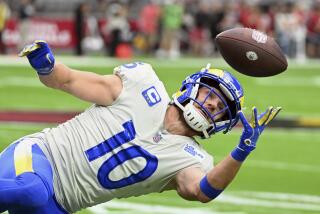They Help Give Quarterbacks a Leg to Stand On
- Share via
‘This man (Joe Namath) could not even walk, much less play football. The brace allowed him to play.’
--DR. RENE CAILLIET, director of Rehabilitation Medicine at Santa Monica Hospital Medical Center.
First developed for Joe Namath (far left, as a member of the Rams) 17 years ago, knee braces have become almost commonplace today around the NFL, worn by players like Dolphin quarterback Dan Marino (left).
Defensive lineman Bob Golic of the Cleveland Browns felt the jolt and heard the pop. Right away he knew: this could be it for the knee.
The game stopped, and in a hushed scene, players stood around as Golic was examined by the Browns’ trainer. Asked where it hurt, Golic said nowhere, but what about the pop?
It was nothing. The noise Golic heard was simply a rivet popping on his knee brace.
“Twice last year, I had the rivets sheared off,” he said by telephone from Cleveland. “You can imagine what would have happened if I hadn’t had that brace on.
“As many shots as I’ve taken on my legs, I can’t imagine being out there without protection.”
First developed for Joe Namath 17 years ago, knee braces have become almost commonplace around the NFL, worn by, among others, Dan Marino, Jim McMahon, Ken O’Brien, Jim Kelly, Phil Simms and Bob Crable.
On many NFL teams braces are mandatory at some positions, like the interior line and linebacker.
They’re being worn at the high school and college levels, too.
Several kinds are available. The Lenox-Hill Derotation Brace, which is custom-made and costs about $425, appears to be the one used most by players, like Golic, who have suffered serious knee injuries.
It was invented for Namath in 1969.
“This man could not even walk, much less play football,” Dr. Rene Cailliet, director of Rehabilitation Medicine at Santa Monica Hospital Medical Center, said of Namath. “The brace allowed him to play.”
George Ganzekaufer, vice president of Lenox Hill Brace, Inc., estimates that about 10 percent of all NFL players -- 100 to 150 athletes -- wear the brace.
The Anderson Knee Stabler, invented in 1977 by George Anderson, head trainer of the Los Angeles Raiders, for former quarterback Ken Stabler, also is popular.
Anderson believes between 280 and 300 NFL players wear his brace, more as a preventive measure or for less serious knee injuries.
Golic wears a Lenox-Hill on one knee and an Anderson on the other.
Anderson said his brace doesn’t need to be custom made; he has four models, the most expensive of which costs $56. The Lenox-Hill covers the entire knee, while the Anderson can be taped or strapped to the outside of the knee.
“I think all linemen should wear something,” Golic said. “I don’t think the Anderson brace affects mobility at all. The Lenox-Hill initially feels more restrictive. I had to wear it out of necessity. But after about a week, you start getting used to it.
“I’ve been wearing it for four years, I wouldn’t go out there without it. I’ve tried wearing the Lenox-Hill on both knees, but it doesn’t work for me. I have a tendency to catch the inside hinges. There’s nobody around me and I fall down. That’s kind of embarrassing on film.”
Speedy wide receiver Dokie Williams of the Los Angeles Raiders recalls wearing an Anderson brace for the first three games of the 1985 season because a knee was bothering him.
Did it hamper his mobility?
“Not much at all, if any,” Williams said. “As a matter of fact, I was playing better when I was wearing it. I stopped because my knee stopped bothering me and it just took longer to put on my equipment.
“It makes sense to wear them. For me, it was just pure laziness. For most guys, it’s probably because they’ve never tried it and it looks like it might hamper their mobility. With me, there was no problem.”
Bill Tessendorf, the Browns’ head trainer, said, “A lot of players have told me they would have had serious injuries if it hadn’t been for a brace. But some people don’t like to have anything extra on their knees or bodies.
“I’ll tell you the perfect analogy: ‘I don’t want to wear hip pads because they’re too bulky.’ Then you get caught with a hip pointer and you wouldn’t play without them.”
Crable, the New York Jets’ linebacker, wears a Lenox-Hill because of an injury he suffered several years ago.
“The old Lenox-Hill slowed me down,” he said. “The new one doesn’t seem to be that way. It’s a lot lighter. It just doesn’t bother me like the old one did.
“Once I’m 100 percent, I don’t know if I’m going to throw it down or not. I think it’s basically an old-time stigma that knee braces limit your mobility, slow you down. In this game, speed’s the name of the game.”
UCLA Coach Terry Donahue likes knee braces, and he doesn’t care if they slow a player down or not.
“I believe they should be mandatory,” he said. “When it’s even across the board, what does it matter (if it slows down a player)?
“I’d like to see every player on the field, with the exception maybe of a kicker, wear them. I’d like to see them be like mouthpieces, as required equipment. But I don’t think it’s going to happen,” Donahue said.
Statistics aren’t available on whether knee braces actually help reduce knee injuries, but opinions are clear-cut.
“If players wear braces and it’s not going to limit their mobility, knee injuries will be cut by probably around 80 percent,” Ganzekaufer said. “And those that do occur will not be as severe.”
Said Anderson: “We’ve had one medial ligament surgery since 1981, and that was a freak injury. I think they should be mandatory. I hope at some point every high school kid is wearing one. If everybody wore some kind of a brace, knee injuries would be cut considerably. It’s hard to come up with a percentage.”
Pepper Burris, the Jets’ trainer, said he’s not sure about percentages, either.
“The jury is still out,” he said. “I think preliminary statistics indicate that some form of a preventative knee brace will cut down on injuries and the severities of the injuries that occur.
“But many of the knee injuries we’re seeing now are not necessarily from a blow from another athlete. Non-contact injuries are occurring. It’s (artificial) turf-related. I don’t think a brace will do anything for that.”
Jim Anderson, the head trainer of the Los Angeles Rams, would like to see knee braces as standard equipment for young players.
“I don’t know if they’ll ever be mandatory in the pros but I think possibly in high schools they might be some day,” he said. “There are probably a lot of guys out there who never get a chance to play because they got hurt in high school.”
More to Read
Go beyond the scoreboard
Get the latest on L.A.'s teams in the daily Sports Report newsletter.
You may occasionally receive promotional content from the Los Angeles Times.










